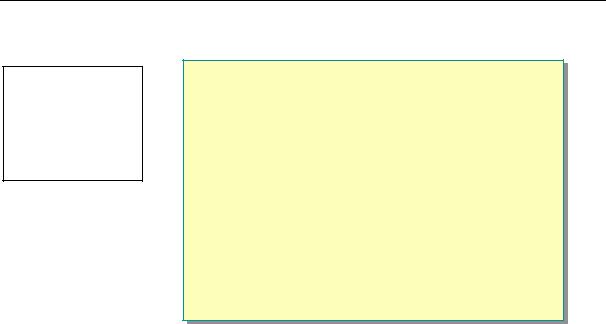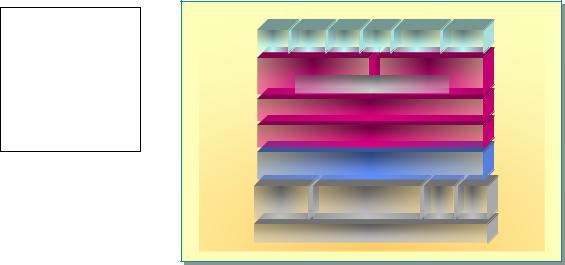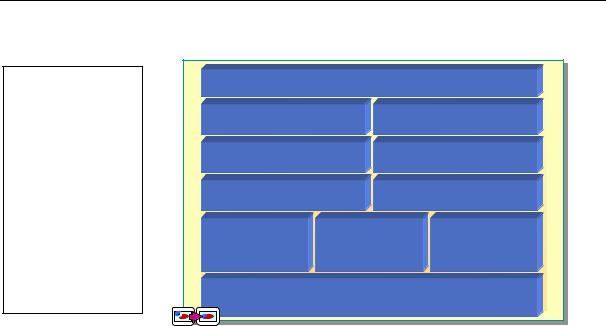
C# ПІДРУЧНИКИ / c# / MS Press - Msdn Training Programming Net Framework With C#
.pdfModule 1: Overview of the Microsoft .NET Framework |
iii |
|
|
|
|
Instructor Notes
Presentation:
30 Minutes
Lab:
00 Minutes
This module provides students with an overview of the Microsoft® .NET Framework. It defines some of the terminology that is specific to the .NET Framework and describes the key features and benefits of the .NET Framework.
The module starts with an overview of the .NET Framework, and then introduces the namespaces in the .NET Framework. It explains which modules teach which namespaces, and which namespaces are not covered in this course.
Do not spend too much time on this module. This module is designed to provide only an overview, so do not go into too much detail.
This module contains no labs.
After completing this module, students will be able to:
!Describe the .NET Framework and its components.
!Explain the relationship between the .NET Framework class library and namespaces.
Materials and Preparation
This section provides the materials and preparation tasks that you need to teach this module.
Required Materials
To teach this module, you need the Microsoft PowerPoint® file 2349B_01.ppt.
Preparation Tasks
To prepare for this module, you should read all of the materials for this module.
iv |
Module 1: Overview of the Microsoft .NET Framework |
Module Strategy
Use the following strategy to present this module:
!The .NET Framework
Explain each part of the .NET Framework. One important goal of this slide is to explain what this course covers. This course primarily teaches the common language runtime and the .NET Framework class library. This course uses Microsoft Visual C#™ to teach the .NET Framework. Only minimal coverage of XML Web services, user interfaces, ADO.NET, and ASP.NET is provided. Other courses will cover these technologies in more detail. In addition, ADO.NET is covered more fully in Module 16, “Using Microsoft ADO.NET to Access Data,” in Course 2349B, Programming with the Microsoft .NET Framework (Microsoft Visual C# .NET).
!Common Language Runtime
This is a build slide. Explain each of the following topics as they appear. Definitions of these topics are found in the content.
•Class Loader
•Microsoft Intermediate Language (MSIL) to Native compilers, Code Manager, and Garbage Collection
•Security Engine, Debugger, Type Checker, Exception Manager, Thread Support, and COM Marshaler
•.NET Framework Class Library Support
!The .NET Framework Class Library
Explain the benefits of the .NET Framework class library. Explain that the common type system is covered in more detail in Module 5, “Common Type System,” and Module 6, “Working with Types,” in Course 2349B,
Programming with the Microsoft .NET Framework (Microsoft Visual C#
.NET). Specific classes are covered in Module 7, “Strings, Arrays, and Collections,” and other modules as appropriate.
!ADO.NET: Data and XML
This is a build slide. Explain the following topics as they appear.
•System.Data
Explain how this namespace works primarily with data, such as data from databases.
•System.Xml
Explain how this namespace works primarily with XML and Extensible Stylesheet Language (XSL).
Module 1: Overview of the Microsoft .NET Framework |
v |
|
|
|
|
!What Is an XML Web Service?
This slide is the key slide for explaining XML Web services. Be sure that everyone understands the role of Web Services Description Language (WSDL), Universal Description, Discovery, and Integration (UDDI), SOAP, XML, and HTTP. Also explain that the .NET software development kit (SDK) and Microsoft Visual Studio® .NET provide tools to simplify the creation of XML Web services.
Note that XML Web services are appropriate for internal applications in addition to external applications. An organization is likely to run multiple platforms; XML Web services are a good way of working across platforms because they rely on XML and SOAP. Any platform that supports XML and SOAP can use or expose XML Web services.
!Web Forms and XML Web Services
Explain how ASP.NET classes make it easier to work with user data on Web pages.
!Namespaces
Briefly explain the purpose of each namespace. The key point to explain is that there are a lot of data types and functionality in the .NET Framework. Namespaces arrange the types in a hierarchy that make it easier to work with the types.
!Namespaces Used in this Course
Briefly explain which modules teach which namespaces. Explain that not all of the namespaces are taught in their entirety. For example, the System.Reflection namespace is mentioned in Module 4, “Deployment and Versioning,” in Course 2349B, Programming with the Microsoft .NET Framework (Microsoft Visual C# .NET), only in terms of versioning.
System.Reflection is also mentioned in Module 17, “Attributes,” in Course 2349B, Programming with the Microsoft .NET Framework (Microsoft Visual C# .NET).
Also, explain that the ADO.NET namespace is covered more fully in Module 16, “Using Microsoft ADO.NET to Access Data,” in Course 2349B, Programming with the Microsoft .NET Framework (Microsoft Visual C# .NET).
The security namespace is not taught in this course as security is covered extensively in Course 2350A, Securing and Deploying Microsoft .NET Assemblies.

Module 1: Overview of the Microsoft .NET Framework |
1 |
|
|
|
|
Overview
Topic Objective
To provide an overview of the module topics and objectives.
Lead-in
In this module, you will be introduced to the .NET Framework. You will then learn about the namespaces and which modules teach certain namespaces.
!Overview of the Microsoft .NET Framework
!Overview of Namespaces
*****************************ILLEGAL FOR NON-TRAINER USE******************************
The Microsoft® .NET Framework provides tools and technologies that you need to build distributed Web applications. In this module, you will learn the architecture of the .NET Framework. You will also learn how the .NET Framework class library is divided into namespaces, and which namespaces are taught in this course.
After completing this module, you will be able to:
!Describe the .NET Framework and its components.
!Explain the relationship between the .NET Framework class library and namespaces.

2Module 1: Overview of the Microsoft .NET Framework
" Overview of the Microsoft .NET Framework
Topic Objective
To provide an overview of the .NET Framework topics.
Lead-in
In this section, you will learn about the Microsoft .NET Framework.
!The .NET Framework
!Common Language Runtime
!The .NET Framework Class Library
!ADO.NET: Data and XML
!What is an XML Web Service?
!Web Forms and Services
*****************************ILLEGAL FOR NON-TRAINER USE******************************
In this section, you will learn about the .NET Framework. The .NET Framework is a set of technologies that form an integral part of the Microsoft
.NET platform. It provides the basic building blocks for developing Web applications and XML Web services.
This section includes the following topics:
!The .NET Framework
!Common Language Runtime
!The .NET Framework Class Library
!ADO.NET: Data and XML
!What is an XML Web Service?
!Web Forms and Services

Module 1: Overview of the Microsoft .NET Framework |
3 |
|
|
|
|
The .NET Framework
Topic Objective
To understand the architecture of the .NET Framework.
Lead-in
The .NET Framework is an architecture consisting of a runtime, the class library, and language support.
VB |
C++ |
C# Perl |
Python |
|
… |
|
Web Services |
User Interface |
|||||
|
|
|
ASP.NET |
|
|
|
|
|
ADO.NET: Data and XML |
|
|
||
|
|
.NET Framework Class Library |
|
|||
|
|
Common Language Runtime |
|
|||
Message |
|
COM+ |
|
|
|
|
|
(Transactions, Partitions, |
IIS |
WMI |
|||
Queuing |
|
|||||
|
Object Pooling) |
|
|
|
||
|
|
|
|
|
|
|
Win32
*****************************ILLEGAL FOR NON-TRAINER USE******************************
The .NET Framework
The .NET Framework provides the necessary compile time and runtime foundation to build and run .NET applications. The .NET Framework is the primary focus of this course.
Platform Substrate
The .NET Framework must run on an operating system. Currently, the .NET Framework is built to work on the Microsoft Win32® operating systems. In the future, the .NET Framework will be extended to run on other platforms, such as Microsoft Windows® CE.
Application Services
When running on Microsoft Windows 2000, application services, such as
COM+, Message Queuing, Windows Internet Information Server (IIS), and
Windows Management Instrumentation (WMI), are available to the developer.
The .NET Framework exposes application services through classes in the .NET
Framework class library.
Common Language Runtime
The common language runtime simplifies application development, provides a robust and secure execution environment, supports multiple languages, and simplifies application deployment and management.
The common language runtime environment is also referred to as a managed environment, in which common services, such as garbage collection and security, are automatically provided.

4Module 1: Overview of the Microsoft .NET Framework
The .NET Framework Class Library
The .NET Framework class library exposes features of the runtime and provides other high-level services that every developer needs. The classes simplify development of .NET applications. Developers can extend them by creating their own libraries of classes.
ADO.NET
ADO.NET is the next generation of Microsoft ActiveX® Data Object (ADO) technology. ADO.NET provides improved support for the disconnected programming model. It also provides rich XML support.
ASP.NET
Microsoft ASP.NET is a programming framework that is built on the common language runtime. ASP.NET can be used on a server to build powerful Web applications. ASP.NET Web Forms provide an easy and powerful way to build dynamic Web user interfaces (UI).
XML Web Services
The .NET Framework provides tools and classes for building, testing, and distributing XML Web services.
User Interfaces
The .NET Framework supports three types of user interfaces:
!Web Forms, which work through ASP.NET
!Windows Forms, which run on Win32 clients
!Console applications, which for simplicity, are used for most of the labs in this course

Module 1: Overview of the Microsoft .NET Framework |
5 |
|
|
|
|
Languages
Any language that conforms to the Common Language Specification (CLS) can run on the common language runtime. In the .NET Framework, Microsoft provides Microsoft Visual Basic®, Microsoft Visual C++®, Microsoft
Visual C#™, and Microsoft JScript® support. Third parties can provide additional languages.
Note C# has been submitted for standardization to ECMA, a vendor-neutral international standards organization committed to driving industry-wide adoption of information and communications technologies. This standardization will make it possible for any company which wishes to implement C# programming tools on any platform to do so. Microsoft has also submitted a subset of the Microsoft .NET Framework, called the Common Language Infrastructure (CLI), to ECMA. This will make it possible for other vendors to implement the CLI on a variety of platforms, so that software written using the basic architectural model presented by the .NET Framework can be created using a variety of tools on a variety of platforms.
Building Components in the .NET Framework
In the .NET Framework, components are built on a common foundation. You no longer need to write the code to allow objects to interact directly with each other. In addition, you no longer need to write component wrappers in the .NET environment, because components do not use wrappers. The .NET Framework can interpret the constructs that developers are accustomed to using in objectoriented languages. The .NET Framework fully supports class, inheritance, methods, properties, events, polymorphism, constructors, and other objectoriented constructs.

6Module 1: Overview of the Microsoft .NET Framework
Common Language Runtime
Topic Objective
To highlight some of the key components in the common language runtime.
Lead-in
This topic will give you an overview of the components of the common language runtime. I will briefly describe each component. As a C# developer, you will never see these discrete pieces, but this discussion will give you a better understanding of the richness of the runtime.
.NET Framework Class Library Support |
||
Thread Support |
|
COM Marshaler |
Type Checker |
|
Exception Manager |
Security Engine |
|
Debugger |
MSIL to Native |
Code |
Garbage |
Compilers |
Manager |
Collection |
Class Loader |
||
*****************************ILLEGAL FOR NON-TRAINER USE******************************
The common language runtime simplifies application development, provides a robust and secure execution environment, supports multiple languages, and simplifies application deployment and management.
The common language runtime environment is also referred to as a managed environment, one in which common services, such as garbage collection and security, are automatically provided. The common language runtime features are described in the following table.
Component |
Description |
|
|
Class loader |
Manages metadata, and the loading and layout of classes. |
Microsoft Intermediate Language |
Converts MSIL to native code on a just-in-time basis. |
(MSIL) to native compiler |
|
Code manager |
Manages code execution. |
Garbage collection |
Provides automatic lifetime management of all of objects in the .NET |
|
Framework, garbage collection is a multiprocessor, scalable garbage collector. |
Security engine |
Provides evidence-based security, based on user identity and the origin of the |
|
code. |
Debugger |
Enables the developer to debug an application and trace the execution of code. |
Type checker |
Does not allow unsafe casts or uninitialized variables. MSIL can be verified to |
|
guarantee type safety. |
Exception manager |
Provides structured exception handling, which is integrated with Windows |
|
Structured Exception Handling (SEH). Error reporting has been improved. |
Thread support |
Provides classes and interfaces that enable multithreaded programming. |
COM marshaler |
Provides marshaling to and from COM. |
.NET Framework class library |
Integrates code with the runtime that supports the .NET Framework class library. |
support |
|
